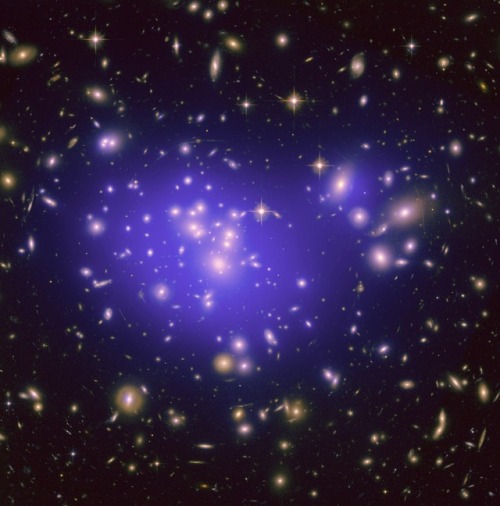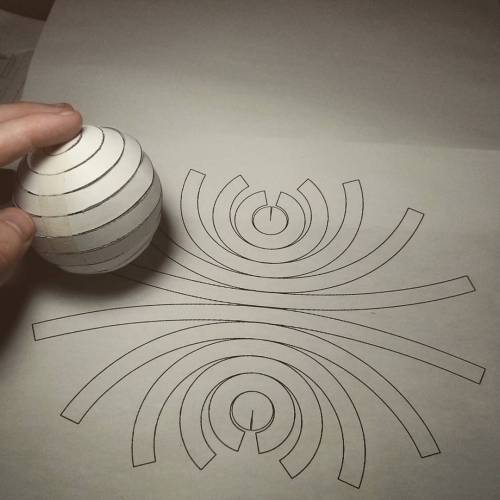Hannahhaifisch - HH
More Posts from Hannahhaifisch and Others

In slow motion, vortex rings can be truly stunning. This video shows two bubble rings underwater as they interact with one another. Upon approach, the two low-pressure vortex cores link up in what’s known as vortex reconnection. Note how the vortex rings split and reconnect in two places – not one. According to Helmholtz’s second theorem a vortex cannot end in a fluid–it must form a closed path (or end at a boundary); that’s why both sides come apart and together this way. After reconnection, waves ripple back and forth along the distorted vortex ring; these are known as Kelvin waves. Some of those perturbations bring two sides of the enlarged vortex ring too close to one another, causing a second vortex reconnection, which pinches off a smaller vortex ring. (Image source: A. Lawrence; submitted by Kam-Yung Soh)
Note: As with many viral images, locating a true source for this video is difficult. So far the closest to an original source I’ve found is the Instagram post linked above. If you know the original source, please let me know so that I can update the credit accordingly. Thanks!

Galaxy Cluster Abell 1689
This image shows the galaxy cluster Abell 1689, with the mass distribution of the dark matter in the gravitational lens overlaid (in purple). The mass in this lens is made up partly of normal (baryonic) matter and partly of dark matter. Distorted galaxies are clearly visible around the edges of the gravitational lens. The appearance of these distorted galaxies depends on the distribution of matter in the lens and on the relative geometry of the lens and the distant galaxies, as well as on the effect of dark energy on the geometry of the Universe.
Credit: NASA/ESA

#SCOPENewYork 2016 | Exhibitor Highlight | Nil Gallery - Booth B05
[Ardan Ozmenoglu, Olive Tree, 2008, paint on glass, 31 x 31 in.]
@ardanozmenoglu
Find out more at SCOPE-ART.COM

38.8256322, 33.1437783

Scientists discover a 2-D magnet
Magnetic materials form the basis of technologies that play increasingly pivotal roles in our lives today, including sensing and hard-disk data storage. But as our innovative dreams conjure wishes for ever-smaller and faster devices, researchers are seeking new magnetic materials that are more compact, more efficient and can be controlled using precise, reliable methods.
A team led by the University of Washington and the Massachusetts Institute of Technology has for the first time discovered magnetism in the 2-D world of monolayers, or materials that are formed by a single atomic layer. The findings, published June 8 in the journal Nature, demonstrate that magnetic properties can exist even in the 2-D realm – opening a world of potential applications.
“What we have discovered here is an isolated 2-D material with intrinsic magnetism, and the magnetism in the system is highly robust,” said Xiaodong Xu, a UW professor of physics and of materials science and engineering, and member of the UW’s Clean Energy Institute. “We envision that new information technologies may emerge based on these new 2-D magnets.”
Xu and MIT physics professor Pablo Jarillo-Herrero led the international team of scientists who proved that the material – chromium triiodide, or CrI3 – has magnetic properties in its monolayer form.
Read more.

Sentinels of the Arctic http://go.nasa.gov/2n1ynuo

LIGO scientists detected a third gravitational wave from two colliding black holes.
This week, scientists using the Laser Interferometer Gravitational-Wave Observatory, or LIGO, announced that they had detected another gravitational wave—the third ripple observed since September 2015. The findings were published in the journal Physical Review Letters.
The source of this most recent gravitational wave is a black hole 49 times larger than our sun that was formed by two colliding black holes located 3 billion light-years away. The data indicates that the spin of one or both of the black holes may have a tilted orbit, which can reveal clues to their origins. Theoretical astrophysicist Priyamvada Natarajan explains how this finding sheds light on black hole formation, and how it affects our understanding of general relativity and dark matter. Listen here.
[Image credit: LIGO/Caltech/MIT/Sonoma State (Aurore Simonnet)]

Can you flatten a sphere?
The answer is NO, you can not. This is why all map projections are innacurate and distorted, requiring some form of compromise between how accurate the angles, distances and areas in a globe are represented.
This is all due to Gauss’s Theorema Egregium, which dictates that you can only bend surfaces without distortion/stretching if you don’t change their Gaussian curvature.
The Gaussian curvature is an intrinsic and important property of a surface. Planes, cylinders and cones all have zero Gaussian curvature, and this is why you can make a tube or a party hat out of a flat piece of paper. A sphere has a positive Gaussian curvature, and a saddle shape has a negative one, so you cannot make those starting out with something flat.
If you like pizza then you are probably intimately familiar with this theorem. That universal trick of bending a pizza slice so it stiffens up is a direct result of the theorem, as the bend forces the other direction to stay flat as to maintain zero Gaussian curvature on the slice. Here’s a Numberphile video explaining it in more detail.
However, there are several ways to approximate a sphere as a collection of shapes you can flatten. For instance, you can project the surface of the sphere onto an icosahedron, a solid with 20 equal triangular faces, giving you what it is called the Dymaxion projection.
The Dymaxion map projection.
The problem with this technique is that you still have a sphere approximated by flat shapes, and not curved ones.
One of the earliest proofs of the surface area of the sphere (4πr2) came from the great Greek mathematician Archimedes. He realized that he could approximate the surface of the sphere arbitrarily close by stacks of truncated cones. The animation below shows this construction.
The great thing about cones is that not only they are curved surfaces, they also have zero curvature! This means we can flatten each of those conical strips onto a flat sheet of paper, which will then be a good approximation of a sphere.
So what does this flattened sphere approximated by conical strips look like? Check the image below.
But this is not the only way to distribute the strips. We could also align them by a corner, like this:
All of this is not exactly new, of course, but I never saw anyone assembling one of these. I wanted to try it out with paper, and that photo above is the result.
It’s really hard to put together and it doesn’t hold itself up too well, but it’s a nice little reminder that math works after all!
Here’s the PDF to print it out, if you want to try it yourself. Send me a picture if you do!

0008

Where you will find me today { @ NASA } contemplating formations like ‘cloud streets’ like this activity over the Bering Sea | 📷via @explorenasa + NASA/Goddard | research for #spacelandings2017 #atmosphericresearch #newterrain #environment #sciencematters { cylinders of #spinning #air }
-
 hannahhaifisch reblogged this · 9 years ago
hannahhaifisch reblogged this · 9 years ago